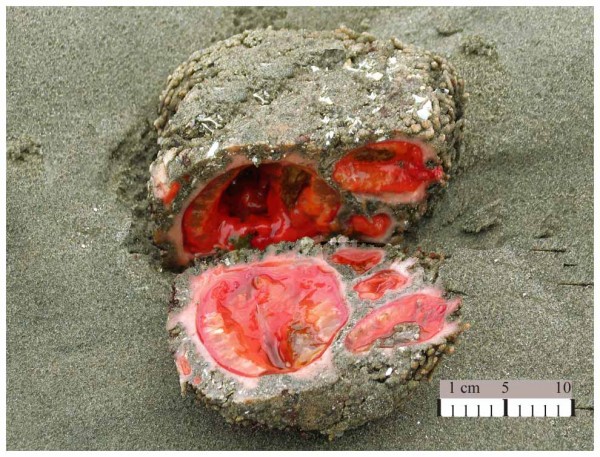Pyura Chilensis, the living rock
Pyura Chilensis, the living rock:

This is not a geode. It's an animal. An apparently delicious animals with clear blood, whose body is accumulates surprisingly large amounts of a rare metal used to strengthen steel.
This is Pyura chilensis—an immobile ocean creature. Besides the other traits I mentioned, P. chilensis is also capable of both sexual and asexual reproduction. At the Running Ponies blog, Becky Crew explains the results of a 2005 study that detailed the creature's breeding habits for the first time.
Read the rest of Becky Crew's post to learn more about Pyura chilensis

This is not a geode. It's an animal. An apparently delicious animals with clear blood, whose body is accumulates surprisingly large amounts of a rare metal used to strengthen steel.
This is Pyura chilensis—an immobile ocean creature. Besides the other traits I mentioned, P. chilensis is also capable of both sexual and asexual reproduction. At the Running Ponies blog, Becky Crew explains the results of a 2005 study that detailed the creature's breeding habits for the first time.
The results showed that P. chilensis is born male, before becoming cosexual – having both male and female gonads – in its adolescence as it increased in size. The researchers also found that given the choice – that is, if situated around other individuals – these organisms prefer to breed via cross-fertilisation, writing, “Given that more events of natural egg spawning followed by successful settlement and metamorphosis were recorded in our paired specimens and in our manipulated cross trials … it appears that cross-fertilisation predominates in this species.”
Manríquez and Castilla also found that a greater number of fertilised eggs resulted from the paired specimens, which suggests that cross-fertilisation, or reproducing with another individual, predominates because it is more effective. This assumption was strengthened by the fact that individuals that had cross-fertilised before being put in isolation took at least two months before successfully producing offspring via selfing. However, they were careful to note that while cross-fertilisation was preferred, selfing did not produce inferior offspring. “No perceptible differences in fertilisation, settlement and metamorphosis success among self and outcross progeny were found,” they reported. This suggests that when stuck alone in the ocean, selfing provides an advantageous opportunity for loner P. chilensis individuals to still pass on their genes.
Read the rest of Becky Crew's post to learn more about Pyura chilensis
Comments
Post a Comment